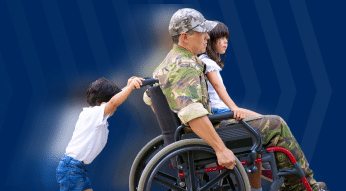Home » VA Disability Conditions List » Mental Conditions Eligible for VA Disability
Mental Conditions Eligible for VA Disability
Service members who witness traumatic or stressful events during their duty can develop mental conditions. VA disability compensation is available to veterans diagnosed with a mental disorder due to their service.
Serving in the armed forces is a brave thing to do. Military service members fight threats against the security of the United States and protect the interests of its people.
Each service member must carry out crucial responsibilities while on active duty. In some cases, they may fight in foreign lands or help support people living in difficult conditions abroad.
Many service members witness distressing events or participate in dangerous or traumatic activities. Being part of a threatening situation — especially if it is recurring and lasts for an extended time — can lead to the development of a mental health condition.
Fortunately, the VA disability benefits program compensates service members who develop mental health conditions due to their experiences. Compensation is also available if the service member had a pre-existing mental health condition that worsened due to their service.
Common Mental Conditions Experienced by Military Service Members
According to the VA, the top three mental health conditions experienced by military service members are post-traumatic stress disorder (PTSD), major depressive disorder, and chronic adjustment disorder.
Post-Traumatic Stress Disorder
PTSD is the most common mental health concern experienced by active-duty service members and veterans. A very intense or long-lasting event that causes significant mental trauma can result in the development of PTSD.
Service members exposed to combat are most likely to experience PTSD symptoms, but anyone who experiences something traumatic can develop the disorder.
The VA notes four classic types of PTSD symptoms:
- Recalling the events as if they are currently happening
- Avoiding things that remind you of a traumatic experience
- Having more negative thoughts or feelings than before the event
- Feeling on edge or keyed up
Every case of PTSD manifests differently, but some common behaviors associated with PTSD include the following:
- Nightmares or flashbacks
- Avoiding crowds, driving, or watching movies or TV that remind you of a traumatic event
- Taking part in avoidance activities or always staying busy
- Feeling numb and losing interest in things you used to enjoy
- Forgetting details of the event or being unable to discuss them
- Not being able to trust anyone
- Being unable to sleep or concentrate
- Acting in unhealthy ways, such as drinking too much, smoking, or taking drugs
Some people with PTSD overcome their symptoms within a few weeks or months. And some require extended therapy to find relief from PTSD symptoms. Medications may help with specific symptoms, like difficulty sleeping or depression.
Common types of therapy used to treat symptoms of PTSD include:
Prolonged Exposure Therapy (PE)
Prolonged exposure therapy involves talking about traumatic experiences with a therapist. The therapist may ask you to repeat the events during each session. Many people with PTSD find that this helps them gain more control over their thoughts and feelings.
Cognitive Processing Therapy (CPT)
Cognitive processing therapy involves talking with a therapist and taking note of the negative thoughts or beliefs that upset you. Over time, you can identify the thoughts that drive your symptoms of PTSD and change the way you think about them. These changes in thinking behavior can help many people overcome trauma.
Eye movement desensitization and reprocessing (EMDR)
EMDR involves talking about a traumatic memory with a therapist while listening to a sound or paying attention to specific movements. As you talk about the memory, you identify negative thoughts or emotions. As the memory becomes less traumatic, you can add positive thoughts to overcome your feelings.
Major Depressive Disorder
Major depressive disorder is the most severe and debilitating form of depression. Individuals suffering from major depressive disorder face a potential reduction in quality of life, including decreased productivity, increased obesity, and enhanced risk of suicide.
If you are having thoughts of self-harm or suicide, please reach out for help immediately by calling 988 to connect with the Suicide and Crisis Lifeline. You don’t have to face this alone.
In addition to reduced quality of life, people suffering from major depressive disorder may experience co-occurring illnesses, such as PTSD or substance abuse issues.
Various factors can influence the development of a major depressive disorder, including genetic, biological, environmental, or psychological factors. Service members who experience major depressive disorder may find their symptoms worsen with intense, stressful situations or traumatic experiences.
Symptoms of major depressive disorder include:
- Depressed mood more often than not
- Diminished interest in activities enjoyed in the past
- Significant weight loss or weight gain
- Insomnia or excessive fatigue
- Inability to concentrate or indecisiveness
- Feelings of low worth or low self-esteem
Service members diagnosed with major depressive disorder often require therapy and medication to stabilize their moods. Frequently, individuals with major depressive disorder experience recurring episodes over time.
Chronic Adjustment Disorder
Chronic adjustment disorder develops due to significant changes or traumatic experiences in life. An adjustment disorder can develop and resolve over a few weeks or months. If symptoms continue, the adjustment disorder is chronic.
Common symptoms associated with chronic adjustment disorder include:
- Feeling sad most of the time or having frequent crying spells
- Anxiety that doesn’t subside
- Difficulty sleeping
- Withdrawing from social support
- Feeling overwhelmed
- Lack of appetite
- Avoiding work or paying bills
Usually, symptoms of an adjustment disorder develop within three months of a traumatic or life-changing event. If they don’t resolve, the condition can be considered chronic. Treatment involves developing healthy habits and undergoing therapy. In some cases, a physician may prescribe medication to alleviate symptoms.
Other Common Mental Conditions
Service members may experience other mental conditions as a result of their experiences. Other common conditions include:
- Anxiety
- Schizophrenia
- Bipolar Disorder
- Dementia
- Obsessive-compulsive disorder
- Somatization disorder
- Eating disorders
Getting help through VA disability benefits can often ease the stress associated with a mental condition and support service members in seeking the treatment they need to overcome their symptoms.
Obtaining Treatment Assistance Through the VA
Being diagnosed with a mental illness and getting treatment is the first step to improving. Therapy and medications often help limit symptoms and restore quality of life. The VA offers many treatment options for current service members and veterans to obtain the assistance they need.
People who don’t live close to a VA treatment center may obtain online services through the VA’s Veteran Training portal. In addition, unique smartphone apps for veterans can help relieve symptoms. Service members who call 877-927-8387 can talk with other combat veterans about their situations and experiences.
Combat veterans can visit Vet Centers for free individual or group counseling sessions. You can locate nearby Vet Centers through the VA website.
- FY2021 VA Annual Benefits Report
- PTSD Basics – PTSD: National Center for PTSD (va.gov)
- About Face booklet (va.gov)
- VA/DoD_Clinical_Practice_Guideline_for_the_Management_of_Major_Depressive_Disorder_(MDD)
- Adjustment disorders – Symptoms and causes – Mayo Clinic
- VA Mental Health Services | Veterans Affairs
- Find VA Locations | Veterans Affairs
Client Reviews
Want to Increase Your VA Rating?



